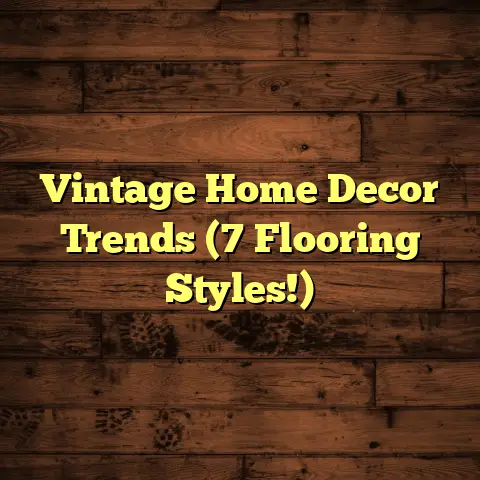Mixing Dark & Light Floors? (2 Style NIGHTMARES!)
Are you tired of spending hours trying to figure out how to blend dark and light flooring without creating an overwhelming visual clash?
I get it.
As a flooring contractor for over 15 years, I’ve seen firsthand the good, the bad, and the downright ugly when it comes to mixing floor colors.
And let me tell you, it’s not always a walk in the park.
Sometimes, it can feel more like navigating a minefield of design disasters!
This article is your guide to dodging those design bullets and creating a space that’s both stylish and harmonious.
Understanding Color Theory in Flooring
Color theory is the bedrock of any successful interior design, and that absolutely includes flooring.
It’s not just about picking colors you like; it’s about understanding how those colors interact and affect the overall feel of a room.
Think of light colors as your space expanders.
They reflect light, making rooms feel larger
and more open.
Whites, creams, light grays, and pale woods are fantastic for brightening up smaller spaces or areas with limited natural light.
Dark colors, on the other hand, bring warmth and coziness.
They absorb light, creating a sense of intimacy and drama.
Dark browns, charcoals, and deep mahoganies can make a large room feel more inviting and grounded.
But here’s the kicker:
Dark colors can also make a small room feel even smaller if not used carefully.
The emotional and psychological impact of color is also crucial.
Light colors often evoke feelings of calmness, cleanliness, and airiness, while dark colors can suggest sophistication, luxury, and even a bit of mystery.
For example, a light, airy kitchen with light wood floors might feel cheerful and inviting, while a dark, moody living room with dark hardwood floors could feel more like a cozy retreat.
It all depends on the vibe you’re going for.
The Aesthetic Appeal of Mixing Floors
So, why would anyone want to mix dark and light floors in the first place?
Well, there are several compelling reasons.
One of the biggest is creating a unique, visually interesting space.
Mixing floor colors can break up the monotony of a single flooring type and add a touch of personality to your home.
It’s a way to say, “Hey, I’m not afraid to take risks and do something different!”
Another reason is to define different areas within an open floor plan.
In a large, open-concept space, using different flooring colors can help visually separate the living room from the dining area or the kitchen from the breakfast nook.
I’ve seen it done beautifully where a light tile defines the kitchen space, transitioning into a dark hardwood in the adjacent living area.
It’s a subtle but effective way to create distinct zones without building walls.
Let’s look at some successful combinations.
Light Gray Tile & Dark Walnut Hardwood:
This combo is modern and chic. The light gray tile keeps things bright and airy, while the dark walnut adds a touch of sophistication and warmth.
* Cream Carpet & Dark Mahogany Hardwood:This pairing is classic and elegant. The cream carpet provides a soft, comfortable feel, while the dark mahogany adds a sense of luxury and grounding.
* Light Oak Hardwood & Black Slate Tile:This combination is bold and dramatic. The light oak keeps the space from
feeling too dark, while the black slate adds a touch of modern edge.
These are just a few examples, but the possibilities are endless.
The key is to choose colors and materials that complement each other and create a cohesive look.
Nightmare #1: The Clash of Styles
Alright, let’s dive into the first nightmare scenario: the clash of styles.
This happens when you mix flooring types that simply don’t belong together, creating a visual discord that’s jarring and unpleasant.
Think of it like wearing stripes and polka dots at the same time – it just doesn’t work!
One of the most common clashes I see is a sleek, modern dark hardwood juxtaposed with a rustic light oak.
The dark hardwood screams contemporary elegance, while the light oak whispers of country charm.
Putting them together is like inviting two completely different personalities to the same party – they’re bound to step on each other’s toes.
Differing textures and finishes can exacerbate visual discord.
Imagine pairing a high-gloss dark tile with a matte light wood.
The shiny tile reflects light like crazy, while the matte wood absorbs it.
The contrast is so stark that it creates a visual imbalance, making the space feel disjointed and chaotic.
Let me share a case study from a recent project:
I had a client who wanted to mix a dark, espresso-colored bamboo flooring with a light, whitewashed pine.
On paper, it sounded interesting, but the result was a disaster.
The bamboo looked sleek and modern, while the pine looked rustic and beachy.
The textures were also completely different – the bamboo was smooth and polished, while the pine was rough and grainy.
The client ended up hating it and asked us to redo the entire floor.
It was a costly mistake that could have been avoided with better planning and a clearer understanding of style compatibility.
Nightmare #2: Inconsistent Maintenance and Durability
Now, let’s talk about the second nightmare: inconsistent maintenance and durability.
This is where the practical implications of mixing dark and light floors come into play.
Different flooring materials have different maintenance requirements and lifespans.
Mixing them can lead to a real headache down the road.
One of the biggest challenges is that dark floors tend to show dust and scratches more easily than light floors.
If you have a dark hardwood floor, you’ll need to sweep or vacuum it regularly to keep it looking its best.
Every little speck of dust and every tiny scratch will be magnified on that dark surface.
Light floors, on the other hand, might stain more readily.
Spills and messes are more likely to leave a mark on a light-colored carpet or tile.
You’ll need to be extra careful about cleaning up spills promptly and using the right cleaning products to prevent permanent stains.
Different materials also have varying lifespans.
A high-quality hardwood floor can last for decades with proper care, while a cheaper laminate floor might only last for 10-15 years.
If you mix these materials, you might end up having to replace one floor while the other is still in good condition.
This can be a costly and inconvenient problem.
Let me give you an example:
I once worked on a house where the homeowner had mixed a dark hardwood in the living room with a light-colored laminate in the kitchen.
The hardwood was holding up beautifully, but the laminate was starting to peel and fade after just a few years.
The homeowner had to replace the laminate, which meant disrupting the entire kitchen and trying to match the new laminate to the existing hardwood.
It was a real hassle, and it could have been avoided by choosing materials with similar lifespans.
Common Mistakes When Mixing Dark and Light Floors
Alright, let’s talk about some of the most common mistakes I see homeowners make when attempting to mix dark and light flooring.
Knowing these pitfalls can help you avoid them and create a stunning, cohesive space.
Not Considering the Lighting:
Lighting is everything! The way light interacts with your flooring can dramatically change its appearance. A dark floor in a poorly lit room will look even darker and can make the space feel claustrophobic. Always consider the natural and artificial lighting in your space before choosing your flooring colors.
* Failing to Account for the Existing Color Palette:Your floors should complement the existing colors in your walls, furniture,
and décor.If you have warm-toned walls, you’ll want to choose flooring colors that also have warm undertones. Mixing warm and cool tones can create a jarring and unpleasant effect.
* Not Testing Samples Together in the Actual Space:This is a big one!Don’t just pick your flooring colors from a catalog or a showroom. Get samples of each color and lay them out in your actual space. Look at them in different lighting conditions and at different times of day. This will give you a much better idea of how the colors will look together in your home.
Transitions are the key to creating aseamless flow between different flooring types. We’ll dive deeper into this in the next section,but for now, just remember that transitions are crucial for tying everything together.
* Ignoring the Flow of Traffic:Think about how people move through
your space. If you have a high-traffic area, you’ll want to choose a durable flooring material that can withstand wear and tear. You might also want to choose a darker color in high-traffic areas to hide dirt and scuff marks.
* Overlooking the Importance of Transitions:
These mistakes can lead to a disjointed or chaotic aesthetic that detracts from the overall beauty of your home.
By avoiding these pitfalls, you’ll be well on your way to creating a stunning and harmonious space.
The Role of Transition Pieces
Transition pieces are the unsung heroes of mixed flooring designs.
They’re the elements that bridge the gap between different flooring types, creating a seamless flow and preventing a jarring visual disconnect.
Think of them as the glue that holds your design together.
There are several types of transition pieces, each designed for specific situations:
Trim: Trim is typically used to cover the edges of flooring where it meets a wall or other vertical surface.It can also be used to create a decorative border around a room.
between two different flooring types at doorways or other openings. They can be made of wood, metal, or other materials and come in a variety of styles and finishes.
* Thresholds:Thresholds are used to transition
* Area Rugs:Area rugs are a great way to definedifferent zones within a room and create a visual transition between different flooring types. They can also add warmth, texture, and color to your space.
The choice of transition can either enhance the look of your mixed flooring or contribute to the nightmare scenarios we discussed earlier.
A well-chosen transition piece will blend seamlessly with the surrounding flooring, creating a smooth and unobtrusive transition.
A poorly chosen transition piece, on the other hand, can stick out like a sore thumb and detract from the overall aesthetic.
For example, using a clunky, mismatched threshold between a dark hardwood floor and a light tile floor can create a jarring visual break.
Instead, you might opt for a sleek, metal threshold that complements both flooring types and creates a subtle transition.
When choosing transition pieces, consider the following factors:
Material:Choose a material that complements both flooring types and is durable enough to withstand wear and tear.
* Color:Choose a color that blends seamlessly with the surrounding flooring or provides a subtle contrast.
* Style:Choose a style that complements the overall aesthetic of your space.
* Height:Make sure the transition piece is the correct height to create a smooth, even surface.
Expert Opinions and Trends
To get some additional perspectives on mixing dark and light floors, I reached out to a few interior designers and flooring experts.
Here’s what they had to say:
“Mixing dark and light floors can be a great way to add visual interest and define different zones within a space,” says Sarah Miller, an interior designer with over 10 years of experience. “However, it’s important to choose colors and materials that complement each other and create a cohesive look. I always recommend testing samples together in the actual space to see how they look in different lighting conditions.”
* “One of the biggest mistakes I seehomeowners make is not considering the maintenance requirements of different flooring materials,” says John Smith, a flooring contractor with over 20 years of experience. “Dark floors tend to show dust and scratches more easily, while light floors might stain more readily. It’s important to choose materials that are durable and easy to maintain, especially in high-traffic areas.”
* “I’m seeing a trend towards using lighter, more natural-looking floors
in general,” says Emily Davis, a trend forecaster specializing in interior design.“However, dark floors are still popular in certain applications, such as bedrooms and living rooms, where they can create a cozy and inviting atmosphere.
The key is to balance dark and light elements to create a visually appealing and harmonious space.”
Current trends in flooring seem to be embracing a more balanced approach to mixing dark and light tones.
While lighter, natural-looking floors are definitely gaining popularity, dark floors are still holding their own in certain areas.
The key is to use them strategically and in combination with lighter elements to create a visually appealing and harmonious space.
For example, you might pair a dark hardwood floor with light-colored walls and furniture to create a sense of balance and contrast.
Or, you might use a light-colored area rug to break up a large expanse of dark flooring and add warmth and texture to the space.
Conclusion
Mixing dark and light floors can be a tricky endeavor.
I’ve seen it result in stunning, personalized spaces, and I’ve also witnessed it devolve into design nightmares.
The potential pitfalls are real: clashing styles, inconsistent maintenance, and a disjointed aesthetic are just a few of the challenges you might face.
But don’t let that scare you off!
With the right approach, careful planning, and a keen eye for detail, you can successfully mix dark and light floors to create a space that’s both stylish and harmonious.
Remember to consider the color theory, avoid common mistakes, and pay attention to the role of transition pieces.
Most importantly, trust your instincts and choose colors and materials that you love.
After all, it’s your home, and you should create a space that reflects your personal style and makes you feel comfortable and happy.





